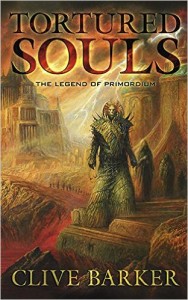 Originally written as a multi-part story to go with a series of Todd MacFarlane action figures, Tortured Souls: The Legend of Primordium is perhaps the most perfectly old-school Clive Barker piece ever written. Which is to say that within its relatively short length, it hits all of the classic Barker tropes and does so unapologetically. There is an ancient, mysterious city (the aforementioned Primordium, which we are told is the first city and which we then learn roughly nothing else about over the course of the rest of the story). There are mismatched lovers inescapably drawn to each other by an act of horrific violence, there is body transformation intertwined with brutal, sadistic sex, there are inversions of gender roles intended to be equal parts grotesque and pathetic, and we have a monstrous, powerful being who lurks at the edges of the story and makes wishes come true in a storm of red agony.
Originally written as a multi-part story to go with a series of Todd MacFarlane action figures, Tortured Souls: The Legend of Primordium is perhaps the most perfectly old-school Clive Barker piece ever written. Which is to say that within its relatively short length, it hits all of the classic Barker tropes and does so unapologetically. There is an ancient, mysterious city (the aforementioned Primordium, which we are told is the first city and which we then learn roughly nothing else about over the course of the rest of the story). There are mismatched lovers inescapably drawn to each other by an act of horrific violence, there is body transformation intertwined with brutal, sadistic sex, there are inversions of gender roles intended to be equal parts grotesque and pathetic, and we have a monstrous, powerful being who lurks at the edges of the story and makes wishes come true in a storm of red agony.
In short, there’s nothing here devoted readers of Barker’s work haven’t seen before, and seen done better. Primordium itself is a particular disappointment. It harbors less mystery than Midian or Yzordderrex; nothing is made of its status as the first of its kind.
The nominal hero of the piece is an assassin (another standard Barker trope, just ask Pie’oh’pah) named Zarles Krieger, who, after fulfilling a contract on a senator of the city, is led to Agonistes by the victim’s daughter. Transformed into the ridiculously named Scythe Meister, Zarles returns to the city and kills the Emperor, while a local crime boss kidnaps, interrogates and kills the senator’s daughter. Bereft, the Scythe Meister brings her to Agonistes, who resurrects her as the monster Lucidique, and the two fall into bed. Meanwhile, the generals of the city decide to have monsters of their own made in order to hunt down the former Zarles, and carnage, disfigurement, and necrophagy ensue.
Everything about the novella feels off-hand and rushed. The over-the-top character names give the distinct sense that they were created for the action figures first and the prose second; Mongroid and Venal Atomica in particular sound like musicians who failed tryouts for GWAR. As for the narrative, it drops loose ends everwhere and regards character motivation as optional. What could have been a magnificent portrait of monstrous love at the heart of a unique setting instead comes across as paint-by-numbers, checking off the boxes that readers expected from Barker in the heady early days of Books of Blood.
As a fan of Barker’s work, it pains me to say that this one is most likely of interest only to completists and the hardest of the hard core. More casual fans are more likely to find themselves asking what all the fuss was about. They’re better served exploring similar themes done better in Cabal or The Damnation Game, or the astonishing Chiliad. But the tale of the first city is most assuredly not the tale of the best.
(Subterranean, 2015)
